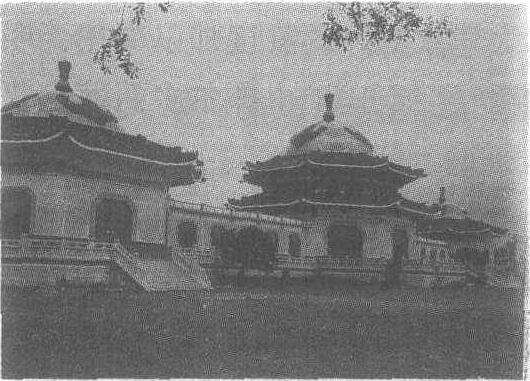成吉思汗陵
成吉思汗(公元1162—1227年)本名铁木真,我国古代著名的军事家和政治家。出生于蒙古部孛儿只斤氏族,他在统一了蒙古各部落后被推举为大汗,遵称成吉思汗,即汗位后制定了一系列的政治、军事、法律等制度,并发动了大规模对外扩张的战争,兼并了大片疆域,1227年病逝于进军西夏的征途中。成吉思汗死后是秘密归葬,其墓穴的地表不留任何痕迹,后世的子孙只好以曾停放过成吉思汗灵柩的“八白室”(八座白色宫帐)作为其象征性的陵寝加以奉祀。明朝时“八白室”由鄂尔多斯部世代守护。清顺治六年(公元1649年)“八白室”迁至今伊金霍洛旗一带。抗日战争时为使成吉思汗陵寝免遭日伪劫持,于1939年5月转移至甘肃省榆中县的兴隆山安放,11年后又迁往青海省湟中县塔尔寺。1954年在内蒙古迎陵代表团的护送下迁回原地,之后国家拨款于1956年建成了永久性的成吉思汗陵园,其座落于内蒙古伊金霍洛旗首府阿腾席连镇南甘德尔山一带。陵园坐北朝南,长宽各15公里,占地面积达225平方公里。陵园的主体建筑是建在高台基上的三座相连的仿蒙古包式的宏伟殿堂,黄、白两色的墙体上配以朱色门窗,内由正殿、寝宫、东西殿、东西廊等组成。八角形的正殿高达26米,蓝琉璃瓦的八角重檐上是蒙古包式的穹庐顶,顶面用黄蓝琉璃瓦镶砌出四朵祥云图案,黄琉璃宝珠顶端。东、西两殿各高23米,除单檐外,形制同正殿,分别有东西廊与正殿相连接。走入正殿,中央是成吉思汗的汉白玉坐像,高达5米。殿后的寝宫置放着黄缎覆盖的三个蒙古包,内安放着成吉思汗及夫人等的灵柩,蒙古包前陈列着相传是成吉思汗生前使用过的头盔、宝剑等物。东、西两廊上是精工彩绘的成吉思汗一生功绩的壁画。东殿内安放着成吉思汗四子拖雷夫妇的灵柩,西殿则供奉着成吉思汗九员猛将的标志旗及使用过的武器等物品。陵园自落成以来,每逢公祭,远近各族群众都会齐集于此,来祭典这位蒙古族的一代天骄。1982年成吉思汗陵被列为全国重点文物保护单位。

成吉思汗陵
成吉思汗陵坐落在伊金霍洛旗境内,距东胜市65公里。陵园依山傍水,总占地面积55544平方米,由三座镶嵌有彩色琉璃瓦的蒙古包殿堂建筑所组成。主体建筑是仿元代城楼式的门庭和三个互相连通的蒙古包式殿,分正殿、东西配殿、东西走廊、后殿六部分。每年农历的三月二十一日、五月十五日、九月十二日和十月初三日成吉思汗的后裔达尔扈特蒙古人都要在此举行盛大的祭奠活动,除了祭奠,还举行赛马、射箭、摔跤等流行活动。场面宏大,十分壮观。这里还不定期地举办元代宫廷宴、诈马宴和鄂尔多斯婚礼表演。
成吉思汗是蒙古杰出的军事家、政治家,他在统一蒙古诸部后于1206年被推为大汗,建立了蒙古汗国。他即位后展开了大规模的军事活动,版图扩展到中亚地区和南俄。1226年率兵南下攻西夏,次年在西夏病死。元代建立后,成吉思汗被追尊为元太祖。
成吉思汗是位传奇性的历史人物,因而他的陵寝对旅游者也有很强的吸引力。成吉思汗陵是1954年修建的,成吉思汗戎马征战一生,一度把蒙古疆域向西延伸到中亚地区和南俄。他的陵墓规模宏大,三个殿之间有走廊连接。在三个蒙古包式宫殿的圆顶上,金黄色的琉璃瓦在灿烂的阳光照射下,熠熠闪光。圆顶上部有用蓝色琉璃瓦砌成的云头花,即是蒙古民族所崇尚的颜色和图案。
正殿高26米,双层屋檐;东西殿高23米,单层屋檐;后殿和走廊高20米;从高处下望,整个大殿像一只雄鹰,正殿像鹰的头和身子,两个侧殿则似在雄鹰展开的双翼。正殿正中摆放成吉思汗的雕像,高5米,身着盔甲战袍,腰佩宝剑,相貌英武,端坐在大殿中央。后殿为寝宫,安放四个黄缎罩着的灵包,包内分别供奉成吉思汗和他的三位夫人的灵枢,灵包的前面摆着一个大供台,台上放置着香炉和酥油灯。这里还摆放成吉思汗生前用过的马鞍等珍贵文物。在通连东西两个侧殿的走廊里,绘有壁画。西走廊绘成吉思汗一生重大事件,东走廊绘成吉思汗孙子——忽必烈的事迹。
在成吉思汗陵东南角,有金顶大帐、侧殿、选汗高台、草原市场、文物陈列馆、射击场、赛马场、摔跤场等设施。金顶大帐高13米,直径18米,是一座蒙古包式的行宫,再现1206年成吉思汗登基时的情景。殿内有成吉思汗宝座和画像,殿外有8辆战车,车轮高2米,可供游人瞻仰观赏。选汗高台高8米,是历史上牧民推选可汗时的仿古建筑。1982年被列为全国重点文物保护单位。
地址:伊金霍洛旗 邮编:017208
电话:86-477-8961017
299 成吉思汗陵
见07070条。
成吉思汗陵Chengjisihanling
在内蒙古伊克昭盟伊金霍洛旗境内。建筑面积1500多平方米,由正殿、东殿、西殿、后殿、东西走廊等组成。四殿互相连接。正殿最引人注目,以美丽的花岗石为底座,四周围以玉石栏杆,殿顶呈浑圆形,高达26米,上面砌着藏蓝、桔黄两色琉璃瓦, 并饰刻着云勾浪纹图案。由蒙、汉文组成的 “成吉思汗陵”五个金色大字竖匾, 高悬在八角飞檐之下, 远远望去, 格外庄严肃穆。殿内正中塑成吉思汗坐像,殿内四壁雕饰着山、水、草、畜等。这里是祭祀活动中心。东西走廊分别绘大型壁画。西走廊绘成吉思汗的出生、遇难、东西征、统一蒙古各部等一生中的重大事件。东走廊壁画, 再现了成吉思汗的孙子忽必烈创立元朝, 以及当时农耕、冶金、桑织等事业的发展及各民族友好团结的景象。东殿安放着成吉思汗的儿子拖雷和夫人的灵柩。西殿展览成吉思汗用过的“苏鲁锭”(长矛)、宝剑和马鞍等遗物。后殿安放着黄色蒙古包四座。堂正中为成吉思汗夫妇的灵柩。每年蒙汉等族人民都到此地举行公祭。

成吉思汗陵内的灵柩
成吉思汗陵
全国重点文物保护单位。位于阿腾连席镇东南15公里处的甘德利草原上。成吉思汗(1162—1227),名铁木真,姓奇渥温,我国古代蒙古族首领、军事家、政治家。毛泽东《沁园春·雪》誉之为“一代天骄”。出生于蒙古部孛儿只斤氏族。代表蒙古贵族利益,于宋开禧二年(1206)统一蒙古诸部,在斡难河之源(今蒙古乌兰巴托东北肯特山鄂嫩河源)被推为大汗,称成吉思汗,蒙语意为“光的精灵般的蒙古大汗”。成吉思汗曾击败俄罗斯、钦察联军,将版图扩展至中亚、南俄,威震欧亚。病逝于进攻西夏途中。其孙忽必烈建立元朝后,追尊他为元太祖。因其死后秘密安葬,墓址无考。其子孙将其生前所用宫帐安放于阿尔泰山、肯特山之间,并建八座白色毡帐,人称“八白室”,成为象征性陵墓。元亡后,帐陵随护陵部族鄂尔多斯部迁移。清顺治六年(1649),鄂尔多斯左翼中旗首领额林沁受封为郡王,任伊克昭盟盟长,遂将帐陵迁于其所辖之境,名其地为伊金霍洛,蒙语为“主人的陵园”之意。抗日战争时,帐陵曾南迁甘肃榆中县兴隆山,后又西迁至青海湟中县塔尔寺。1954年春,迁回今址。1955年正式建立成吉思汗陵。陵园占地面积55000平方米,建筑面积约2000平方米,平面呈丅形。主体建筑由三座以廊道相连的蒙古包式大殿组成。分正殿、寝宫、东殿、西殿、东廊、西廊等部分。正殿高26米,平面为八角形,南向开门,上设重檐,覆以蓝色琉璃瓦,殿顶为蒙古包式穹庐顶,上覆黄蓝两色琉璃瓦并砌成祥云图案,中立黄色琉璃宝珠顶。殿内有成吉思汗坐像,高5米。东西两廊绘有大型壁画。殿后寝宫内安放成吉思汗与其三位夫人及胞弟的象征性灵柩。殿外陈列有战车、兵器,传为成吉思汗征战时所用。两只巨大车轮,传为古代运载成吉思汗灵柩时所用。现每年均在此举行隆重祭祀大典,诵祭词,唱《出征歌》。祭祀完毕即举行那达慕大会。
成吉思汗陵
位于内蒙古伊金霍洛旗阿腾席连镇东南15公里。解放后新建。占地1500多平方米。主体中央纪念堂高20余米,下为八角形,内置通柱,上出重檐,蒙古包式穹庐顶,精工彩绘藻井。顶外部蓝色琉璃瓦砌出云头,镶嵌黄色琉璃砖,并置金黄色琉璃宝顶,金碧辉煌。堂中塑成吉思汗坐像,两廊彩绘成吉思汗生平事迹壁画。堂后寝宫安置黄色蒙古包4座,供奉成吉思汗夫妇以及其孙贵由夫妇的灵柩。
成吉思汗陵
位于内蒙古伊金霍洛旗阿腾席连镇东南7.5公里。始建于1227年,是一座具有民族风格的建筑。在白色墙体上,拱立着3座蒙古包式的穹庐顶。正殿中伫立着一尊高5米的成吉思汗像。后殿供奉着成吉思汗3个妻子及两个弟弟的灵柩。配殿内陈列着成吉思汗当年远征时的遗物如马鞍、宝剑等。整个陵墓占地55000多平方米,庄严肃穆。
成吉思汗陵
在内蒙古伊金霍洛旗阿腾席连镇东南15公里处的甘德尔敖包。1956年由人民政府拨款修建。建筑面积1500多平方米。平面为“⊥”形,主体是中央纪念堂,高20多米,下部呈八角形,上出重檐,蒙古包式穹窿顶。左右两翼有通廊与东、西两殿相连。左右殿皆蒙古式穹窿顶。顶外部用蓝色琉璃瓦砌出云头,镶嵌黄色琉璃砖,并置金黄色琉璃宝顶,成吉思汗当年病逝后采取秘葬,葬址不详。伊金霍洛乃清初供奉其灵柜的地方。在新建陵园的中央纪念堂正中安放着成吉思汗的雕塑坐像,两廊彩绘成吉思汗生平事迹壁画。堂后寝宫置蒙古包4座,供奉成吉思汗夫妇及其孙贵由夫妇的灵柜。每年由政府组织的祭成陵活动,已成为内蒙古各族人民的隆重节日。
成吉思汗陵
简称“成陵”。1954年移建。在内蒙古伊克昭盟伊金霍洛旗席连镇东南15公里。成吉思汗葬地无考, 史载或曰“起辇谷”,或曰“不儿罕山”(今蒙古人民共和国境内大肯特山)。成陵来历史无明载。可能来自成吉思汗遗下的“八白之宝”即八个白色毡殿“斡耳朵”(或“鄂尔多”、“鄂尔多斯”乃其复数格)。1939年6月国民党政府曾将成陵从札萨克旗(今伊金霍洛旗)经榆林—延安—西安移至甘肃榆中县兴隆山。1949年8月,西北军阀马步芳又将其劫往青海湟中县塔尔寺。1953年12月, 内蒙古自治区人民政府应蒙古族人民要求, 呈报中央人民政府政务院批准, 成立了成陵迁移及新陵园建筑委员会, 专事筹办移陵建陵工作。1954年4月成吉思汗灵柩、遗物“苏鲁锭”(长矛)及其他祭器等, 迁回内蒙古。1954年4月23日, 成吉思汗诞生727年大祭时,在原陵地西二里左右的阿勒坦干德利敖包地方, 举行新陵园奠基典礼。1956年5月落成。陵殿由正、后、东、西四宫及东、西过庭六部分组成。几个殿宇顶部呈圆形如蒙古包状, 缠连衔接,宛然一只雄鹰正欲展翅飞翔,绚丽多姿,宏伟壮观,独具蒙古民族建筑特色。如今已成为民族平等团结的象征, 备受蒙古族人民敬仰的名胜, 并与成吉思汗的名字声靡中外。
成吉思汗陵
位于内蒙古鄂尔多斯高原伊金霍洛旗。1956年由人民政府拨款修建,建筑面积为1500m2。正殿高20多m。每年农历3月17日是祭奠日,蒙古族人民要在陵园举行隆重的祭奠仪式。
成吉思汗陵
元太祖成吉思汗的陵墓。位于内蒙古自治区鄂尔多斯中部伊金霍洛旗阿腾席连镇东南15千米,建于1954年春,总面积4万多平方米。陵宫坐北朝南,建筑在1米多高的长方形台基上。
大殿由3个蒙古包式建筑衔接而成。正殿高24米,朱红大门,顶为蒙古包式,顶部有圆柱形装饰和用黄蓝色琉璃瓦砌成的浑厚典雅的云纹图案。顶下双层蓝色八角形正檐。在双层飞檐中间正面悬挂着用蒙汉文写的 “成吉思汗陵”金色大字。殿内中央有5米高的成吉思汗塑像,戴盔披甲,神态威严。殿前约30米处矗立着两根8米多高的旗杆,象征苏力德(军徽)。
东西殿高约21米,顶部装饰与正殿相同,但只有一层檐。东殿里独设一座蒙古包,内安放着成吉思汗的四儿子托雷与其夫人伊喜哈图的灵柩。西殿里供奉着象征着成吉思汗九员大将的有九尖角的旗帜和系挂表示力量的公马与牦牛鬃毛的苏力宝(长矛)。
正殿与西殿之间的长廊里有反映成吉思汗一生中重大事件的大型壁画; 正殿与东殿之间的长廊里的壁画中,描绘了忽必烈统一中国后帝国经济等方面兴盛情况。
寝宫内有用金黄缎子覆盖着的3个蒙古包(亦称 “灵包” ),中间的内部安放着成吉思汗及其3位夫人的灵柩,两边分别是其两个胞弟。蒙古包前放一大供台,台上放置香炉和酥油灯。
每年农历三月二十一、五月十五、八月 十二和十月初三进行祭奠活动,每当这一天,众多的拜谒者在这里举行各种祭祀活动。同时,还举办那达慕大会,演出民族歌舞节目,开展物资交流等项活动。
成吉思汗陵寝的最早形式为明朝末年鄂尔多斯部将的 “八白屋” (八座白色蒙古包,供奉成吉思汗及其夫人)组成,在今伊克昭盟(即大庙——王爱召)附近。清初迁到伊金霍洛。1939年将成吉思汗灵柩移至甘肃省榆中县兴隆山。1949年又运到青海省湟中县塔尔寺。1954年4月7日运回伊金霍洛,决定重建成吉思汗陵园,1956年竣工。成吉思汗陵1981年被国务院确定为全国重点文物保护单位。